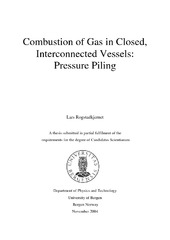| dc.description.abstract | This thesis is the documentation of a study of gas explosions in closed, interconnected vessels. Explosions within such vessels is strongly affected by the characteristics of the geometry, and can, under given conditions, result in very high local peak pressure and rates of pressure rise. In these situations peak pressure andrate of pressure rise can be several factors higher than incomparable single vessel explosions. The term pressure piling or pre-compression is used to describes explosions that show such characteristics pressure development The focus for the present work has been to investigate the effect of fuel properties on pressure piling situations. Altogether more than 500 tests have been conducted with variation in some of the key parameters such as volume ratio between chambers, size and shape of transfer connection, location of ignition point and fuel mixtures. In each test, pressure has been measured and pressure time history recorded. For range of geometries used in this study, the level of pressure piling is consistently lower for hydrogen than for methane. The higher burning velocity of hydrogen is the main cause for this effect. Fast combustion in primary chamber means that the flame uses little time to propagate into the secondary chamber. Consequently only a small portion of gas is able to flow into the secondary chamber and the level of pre-compression is moderate. Subsequent combustion does not result in very high pressure. For this reason lean and rich mixture, which have lower burning velocities, are slightly more prone to pressure piling. The range of burnable concentrations of hydrogen is very wide (5-75%) and the characteristics of these mixtures change significantly with fuel content. Lean mixtures have a low ratio of laminar to turbulent burning velocity whereas rich mixtures typically will flow more easily. Both these factors have been shown to affect hydrogen’s tendency for pressure piling. However, these effects are very geometry dependent and have moderate impact on the general pressure level. Tests of methane air mixtures with various equivalence ratios show that peak pressure is moderately affected by this parameter. In pressure piling situations, peak pressure will typically be just as high for rich and lean mixture as for stoichiometric equivalent mixtures. For slowburning mixtures (rich and lean) more gas will have time to flow into the secondary chamber and thereby compensate for the lower energy content in the gas. In the last phase of this work, the CFD-code FLACS has been used to simulate the experiments and the general trends seen in experiments are also seen in simulations. However FLACS tend to under predict peak pressure due to over prediction of laminar burning velocity in primary chamber. This effect is expected to be less important in larger-scale situations. | en_US |
